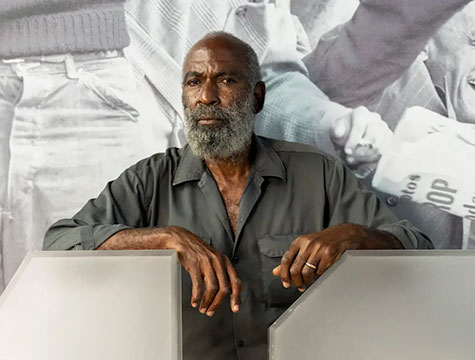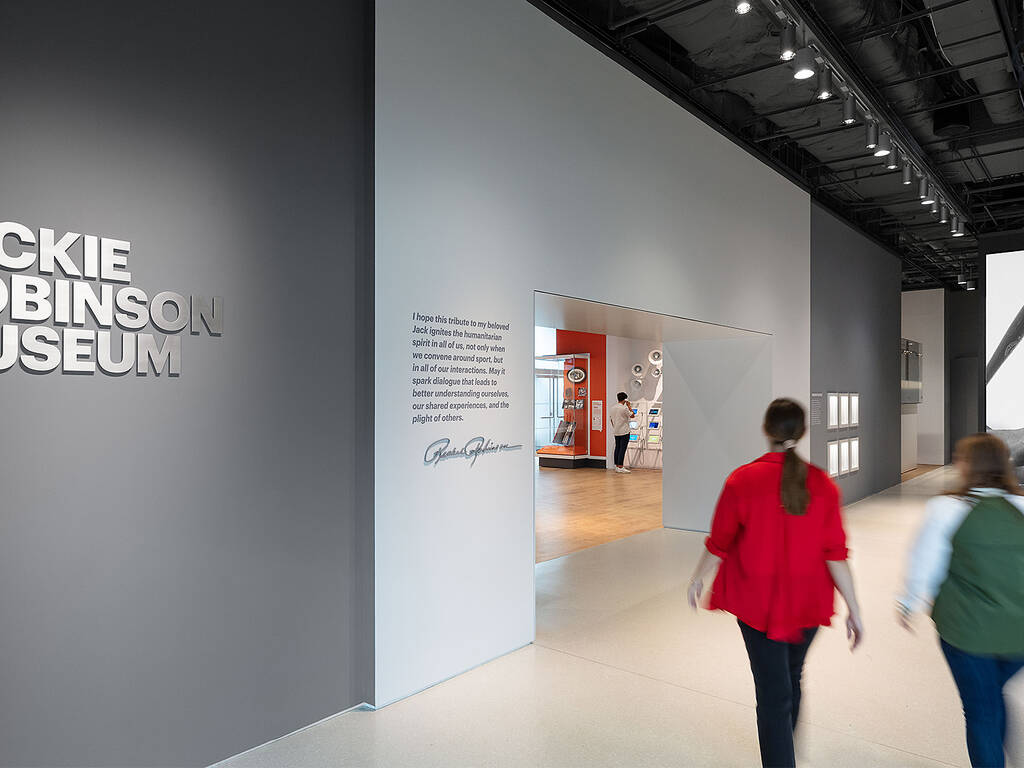
News
The Jackie Robinson Museum Is About a Lot More Than Baseball
Robinson accomplished a great deal on the field, but a museum celebrating his life puts as much focus on his civil rights work.
READ MOREPlan your visit or become a member today! Robinson’s Readers Story Time Kicks Off Dec 13!
Jackie Robinson’s skill on the baseball diamond rarely went unnoticed. No matter where he and the Dodgers traveled, fans of all backgrounds filled stadiums to witness one of the era’s most electrifying players. Between 1949 and 1954, representing the Dodgers and the National League, Robinson earned six consecutive selections to Major League Baseball’s All-Star Game — a testament not only to his exceptional skill, but also to the impact he had on the sport at large.
Robinson’s stats in the Midsummer Classic were remarkable. Across 18 plate appearances, Robinson recorded a .333 batting average against the top pitching of his era, including two doubles and a home run. But more than just numbers, his effective play demonstrated to fans across the country and the world what many already knew: Black players were not only equal in skill to their white counterparts, but they were also stars.
It is important to remember that the 1949 edition was not Jackie’s first All-Star Game. In 1945, while wearing a uniform for the Kansas City Monarchs, Robinson took the field at the East-West game, an annual tradition dating back to 1933, the same year the white major leagues’ All-Star Game was inaugurated. Over 30,000 fans packed into Chicago’s Comiskey Park to see a constellation of top players in the Negro Leagues, including Robinson, Quincy Trouppe, Buck Leonard, and future Dodger catcher Roy Campanella.
Robinson was the starting shortstop for the West. Although he went hitless in five at-bats, it didn’t matter. The West jumped to an 8–0 lead by the third inning, and the game ended with Robinson making a stellar play at shortstop to secure the victory. Just weeks later, his historic journey to the major leagues began when Dodgers scout Clyde Sukeforth came calling.

Negro Leaguers line up for a photo at the 1936 East-West Game at Comiskey Park in Chicago. These games, which showcased the best of the Negro Leagues, continued until 1962. Wikimedia Commons
Though he had an impressive rookie season in 1947 with the Brooklyn Dodgers, and an even better 1948, Jackie Robinson’s first MLB All-Star Game was not until 1949. Fittingly enough, the game was held at Brooklyn’s Ebbets Field. Robinson was joined on the National League squad by his barrier-breaking Dodgers teammates Don Newcombe and Roy Campanella. Larry Doby, the first Black player in the American League, represented the Cleveland Indians in the other dugout. Together, the four players integrated the All-Star Game.
Chaos on the field quickly overshadowed the momentous occasion. The game was a slugfest, with the American League carrying the day by a score of 11 to 7. The National League committed five errors (including one each by Dodgers Pee Wee Reese and Roy Campanella), setting a record for most errors in an All-Star Game by a single team that remains unbroken. Robinson, for his part, was flawless. He played a perfect nine innings at second base and made his mark at the plate.
In his first at-bat, he doubled to left off of the Red Sox’ Mel Parnell and came around to score on Stan Musial’s home run. In his next time at the plate, he drew a walk. When Musial followed with a single to left, Robinson showed off his blazing speed by dashing to third and scoring on Ralph Kiner’s double play soon after.
Though the AL won the game, Robinson was content. Speaking to a reporter after the game, he noted that the quality of play was not top-notch, but being in the game was nonetheless a thrill.

(left to right) Roy Campanella, Larry Doby, Don Newcombe, and Jackie Robinson pose for a photograph at the 1949 All-Star Game. Associated Press
If the previous year’s game was a slugfest, 1950’s was a slog. This time, the National League managed to outlast their counterparts over a 14-inning, 4–3 contest. Robinson, as usual, provided the first spark. Facing the Yankees’ Vic Raschi, Jackie lashed a single to right and scored on Enos Slaughter’s triple a batter later. It would be Robinson’s only hit in the game; he flew out three times before being lifted for a pinch hitter in the 11th.
In 1951, Robinson’s performance was even stronger. In the sixth inning, Robinson drew a walk and promptly scored after teammate Gil Hodges homered to left. His next at-bat in the seventh, however, was quintessential Robinson. With runners on the corners, Robinson waited for the Tigers’ Fred Hutchinson’s delivery and dropped a perfect bunt down the third-base line, scoring Richie Ashburn and giving the National League a 7-3 lead. Robinson would add another hit to his total in the top of the ninth as the team sealed their second victory in a row.
These were not just All-Star appearances. They were clinics on how to influence a ballgame.

Jackie was awarded this cigar box when he was selected to participate in the 1951 All-Star Game. This sterling silver box is engraved with the name of Ford C. Frick, then the president of the National League. Jackie Robinson Museum
The 1952 contest was, by all accounts, soaked by a night of rain and nearly unplayable. But if the field was muddy, Robinson’s swing was crisp. Again, facing Vic Raschi, Jackie stepped to the plate with one down and none on in the top of the first. He smashed Raschi’s first pitch into the upper deck of Shibe’s left-field stands, giving the Dodgers a 1–0 lead.
Three innings later, the Cubs’ Hank Sauer joined in the fun, hitting another home run to give the National League a 3–2 lead. That would be the rest of the scoring that afternoon. During the fourth inning, the rain returned with a vengeance, inundating the players and fans for another frame. By the end of the fifth, the umpires called the game, leaving the National League with another victory. Despite his heroics, Robinson was nonchalant about the result of the game. Not even a home run could prevent Jackie and his competitive spirit from fixating on a misplay he made on a muddy grounder in the fourth inning. “Well, we won, and that’s the main thing,” Robinson said to Dick Young, a New York Daily News reporter with whom he had often clashed. “But I should have had that ball.”

A program for the 1952 All-Star Game. Jackie Robinson Museum
Robinson returned for the 1953 All-Star Game at Cincinnati’s Crosley Field, for the first time as a reserve. The 1953 Dodgers, well on their way to being one of the most dangerous lineups of all time, sent six position players to Cincinnati’s Crosley Field. Robinson entered the game as a pinch hitter in the sixth and popped out. It wasn’t his night, but the National League still won a 5–1 victory.
In 1954, Robinson again returned for his final All-Star Game, this time as a starter. Though the National League lost, Robinson continued his excellent All-Star Play. He started slowly: in the third inning, against the Yankees’ indomitable Whitey Ford, Robinson grounded out. By the next time he came to the plate, Ford had been lifted for Sandy Consuegra, and the National Leaguers had found themselves in a 4–2 hole thanks to an Al Rosen homer the inning before. With runners on first and second, Robinson doubled to right-center, tying the game at four runs apiece.
In the fourth inning, Jackie Robinson was lifted in a defensive substitution for none other than Willie Mays, the face of the next generation of Black superstars. Mays would go on to win both the National League MVP and the World Series with the New York Giants that year. Jackie Robinson, 35 years old and in his eighth season, quite literally made way for Mays to shine on baseball’s biggest stage, and the “Say Hey Kid” did not disappoint. In the eighth inning, Mays singled and scored on Gus Bell’s home run. It would not be enough. After a back-and-forth contest, the American League won 11 to 9.

Jackie Robinson’s profile in the 1955 Brooklyn Dodgers yearbook. Despite slowing down in 1954, Robinson’s performance at the plate and in the field was more than enough to earn him a spot as the National League’s starting left fielder. Jackie Robinson Museum
Across six MLB All-Star Games and one Negro American League’s East-West Game, Jackie Robinson compiled an impressive resume against the top talent in baseball. He and the National League won four out of the six of the games he played, and he recorded a hit in every game in which he was a starter. Jackie Robinson’s All-Star performances helped guarantee his legacy as a top-notch performer on one of the biggest stages in the game. These are major milestones, not just for a ball player, but for a sport, a nation, and a movement.

News
Robinson accomplished a great deal on the field, but a museum celebrating his life puts as much focus on his civil rights work.
READ MORE
News
Visitors will also get to explore an immersive experience “to better understand the racism and prejudice Robinson encountered beyond the baseball field, as well as stories of his lasting influence on sports, politics and entertainment today.”
READ MORE
Programs & Events
Get the scoop on new programs and resources for teachers, students, and families!
READ MORE